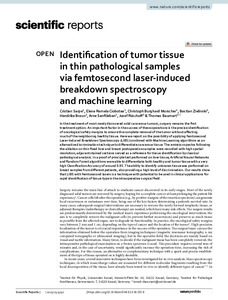| dc.date.accessioned | 2023-11-17T14:30:19Z | |
| dc.date.available | 2023-11-17T14:30:19Z | |
| dc.date.issued | 2023-06-08 | |
| dc.identifier | doi:10.17170/kobra-202311179035 | |
| dc.identifier.uri | http://hdl.handle.net/123456789/15194 | |
| dc.description.sponsorship | Gefördert durch den Publikationsfonds der Universität Kassel | ger |
| dc.language.iso | eng | |
| dc.rights | Namensnennung 4.0 International | * |
| dc.rights.uri | http://creativecommons.org/licenses/by/4.0/ | * |
| dc.subject | Breast cancer | eng |
| dc.subject | Cancer | eng |
| dc.subject | Optical spectroscopy | eng |
| dc.subject | Ultrafast lasers | eng |
| dc.subject.ddc | 530 | |
| dc.title | Identification of tumor tissue in thin pathological samples via femtosecond laser-induced breakdown spectroscopy and machine learning | eng |
| dc.type | Aufsatz | |
| dcterms.abstract | In the treatment of most newly discovered solid cancerous tumors, surgery remains the first treatment option. An important factor in the success of these operations is the precise identification of oncological safety margins to ensure the complete removal of the tumor without affecting much of the neighboring healthy tissue. Here we report on the possibility of applying femtosecond Laser-Induced Breakdown Spectroscopy (LIBS) combined with Machine Learning algorithms as an alternative discrimination technique to differentiate cancerous tissue. The emission spectra following the ablation on thin fixed liver and breast postoperative samples were recorded with high spatial resolution; adjacent stained sections served as a reference for tissue identification by classical pathological analysis. In a proof of principle test performed on liver tissue, Artificial Neural Networks and Random Forest algorithms were able to differentiate both healthy and tumor tissue with a very high Classification Accuracy of around 0.95. The ability to identify unknown tissue was performed on breast samples from different patients, also providing a high level of discrimination. Our results show that LIBS with femtosecond lasers is a technique with potential to be used in clinical applications for rapid identification of tissue type in the intraoperative surgical field. | eng |
| dcterms.accessRights | open access | |
| dcterms.creator | Sarpe, Cristian | |
| dcterms.creator | Ciobotea, Elena Ramela | |
| dcterms.creator | Morscher, Christoph Burghard | |
| dcterms.creator | Zielinski, Bastian | |
| dcterms.creator | Braun, Hendrike | |
| dcterms.creator | Senftleben, Arne | |
| dcterms.creator | Rüschoff, Josef | |
| dcterms.creator | Baumert, Thomas | |
| dcterms.extent | 10 Seiten | |
| dc.relation.doi | doi:10.1038/s41598-023-36155-8 | |
| dc.subject.swd | Brustkrebs | ger |
| dc.subject.swd | Laserinduzierte Breakdown-Spektroskopie | ger |
| dc.subject.swd | Maschinelles Lernen | ger |
| dc.subject.swd | Femtosekundenlaser | ger |
| dc.type.version | publishedVersion | |
| dcterms.source.identifier | eissn:2045-2322 | |
| dcterms.source.journal | Scientific Reports | eng |
| dcterms.source.volume | Volume 13 | |
| kup.iskup | false | |
| dcterms.source.articlenumber | 9250 | |


